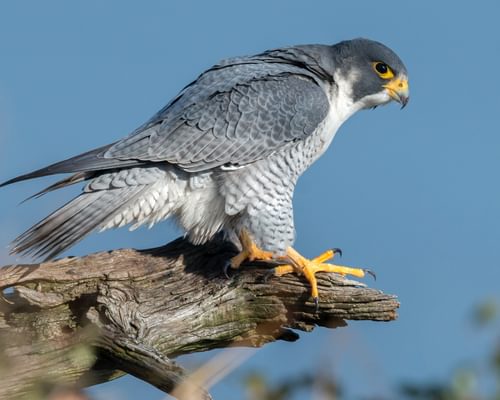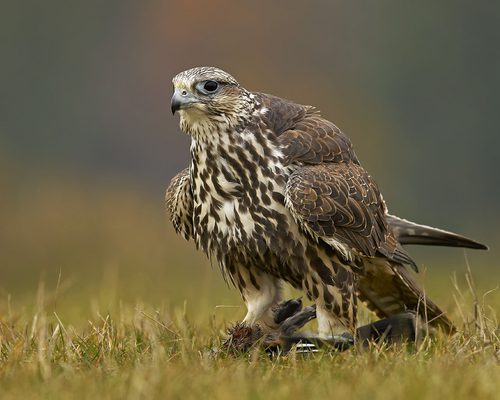Gyrfalcon
Least ConcernFalco rusticolus
Visual Identification
Appearance
The Gyrfalcon is the largest falcon species, with a robust build and broad, pointed wings. Its plumage varies from nearly pure white to dark grey, often with barring or streaking. The head features a distinctive 'moustache' mark and a hooked beak.
Females are noticeably larger and often darker than males. Juveniles typically show more brown colouration and heavier streaking compared to adults. Plumage colour remains consistent year-round.
Size
Length
48cm to 61cm
Wingspan
110cm to 130cm
Weight
800g to 2.1kg
Colours
Males and females have similar plumage
Primary Colour
Grey White
Secondary Colour
Brown Black
Beak Colour
Blue Grey
Leg Colour
Yellow
Habitat and Distribution
Habitats
Woodland
Garden
Wetland
Coastal
Urban
Farmland
Grassland
Desert
Tundra
Rainforest
Mountain
Savanna
Distribution
Gyrfalcons inhabit Arctic and subarctic regions, including tundra, taiga, and mountainous areas. They are found across northern North America, Greenland, and northern Eurasia, with their range extending into Scandinavia and Iceland.
Some individuals move south into southern Canada and the northern United States during winter. They are rare visitors in the UK, occasionally spotted along northern coasts.
Elevation Range
Sea level to 1,500 meters
Climate zones
Arctic, Subarctic, Temperate
Distribution Map
This map gives you a rough idea of where you might spot a Gyrfalcon. The coloured areas show countries where these birds have been seen.
A few things to keep in mind:
- Birds might not be everywhere in the coloured areas, for example, they may be present around the coast of that country
- Where birds live can change with seasons and available food
- This map is quite simple - it doesn't show exact locations
We're working on making our maps even better! Soon, we hope to show you:
- More detailed maps for bigger countries, including state and region
- How birds move around during different seasons
Distribution by Region
Behaviour and Ecology
Bird Attributes
This feature is in beta. We'd love your feedback to improve it!
Share your thoughtsBird Attributes Explained
Our bird attributes system rates various aspects of a bird's capabilities on a scale of 0-100, based on data from field observations, scientific studies, and expert knowledge.
Attribute Categories:
- Agility: Manoeuvrability, speed, and grace in flight or movement.
- Strength: Physical power, often correlating with size and hunting abilities.
- Adaptability: Ability to thrive in various environments or changing conditions.
- Aggressiveness: Territorial behaviour and assertiveness, particularly during breeding seasons.
- Endurance: Stamina, often seen in migration patterns or foraging behaviours.
Understanding the Ratings:
- 0-20: Very Low
- 21-40: Low
- 41-60: Average
- 61-80: High
- 81-100: Very High
Remember, these attributes are relative to other bird species and don't necessarily indicate superiority.
Hover over the icon next to each attribute for more information.
Tap the icon next to each attribute for more information.
Agility
Reflects the bird's manoeuvrability, speed, and grace in flight or movement.
The Gyrfalcon's exceptional agility is evident in its ability to perform intricate aerial manoeuvres and high-speed pursuits. As the largest falcon species, it combines power with remarkable manoeuvrability, capable of reaching speeds over 200 km/h during hunting dives.
Strength
Indicates the bird's physical power, often correlating with size and hunting abilities.
With its robust build and ability to take down medium-sized birds and even Arctic hares, the Gyrfalcon demonstrates impressive strength. Its powerful strikes and ability to carry substantial prey highlight its formidable physical prowess.
Adaptability
Represents the bird's ability to thrive in various environments or changing conditions.
Gyrfalcons show notable adaptability by thriving in harsh Arctic environments and across various habitats from sea level to 1,500 metres elevation. Some individuals even remain in their territories year-round, adapting to extreme conditions including the polar night.
Aggressiveness
Measures the bird's territorial behaviour and assertiveness, particularly during breeding seasons.
While not typically aggressive towards humans, Gyrfalcons display considerable aggression in hunting and territorial behaviour. Their powerful hunting style, willingness to take on relatively large prey, and fierce defence of nesting sites indicate a high level of assertiveness.
Endurance
Reflects the bird's stamina, often seen in migration patterns or foraging behaviours.
The Gyrfalcon's endurance is evident in its ability to perform long, high-speed chases and survive in harsh Arctic conditions. Their partial migratory behaviour and capacity to remain active in extreme cold further demonstrate remarkable stamina and resilience.
Diet
Gyrfalcons primarily hunt medium-sized birds, with ptarmigan and seabirds forming a significant part of their diet. They also take Arctic hares and lemmings. These falcons employ high-speed chases and powerful strikes to capture prey in flight or on the ground.
Behaviour
Gyrfalcons are powerful and agile flyers, capable of high-speed pursuits and impressive aerial manoeuvres. They often perch on prominent rocks or cliffs, scanning for prey. During breeding season, pairs engage in spectacular courtship flights, performing intricate aerial displays.
Vocalisation
Gyrfalcons have a range of vocalisations, including a loud, repeated 'kak-kak-kak' call used during territorial disputes and breeding. They also produce softer chirps and wails during courtship. Their calls are generally deeper and more powerful than those of other falcon species.
Nesting & Breeding
Gyrfalcons form monogamous pairs and begin courtship in late winter. They typically nest on cliff ledges or rocky outcrops, sometimes using old nests of other large birds.
Females lay 2-5 eggs, which are pale cream with reddish-brown spots. The eggs are incubated primarily by the female for about 35 days.
Chicks fledge after 7-8 weeks but remain dependent on their parents for several more weeks, learning hunting skills before becoming fully independent.
Lifespan
years
The Gyrfalcon typically lives for 12 to 20 years.
Like all birds, lifespan can be affected by factors including predation, habitat quality, disease, and access to food sources.
Conservation and Status
Global Conservation Status
While listed as Least Concern globally, Gyrfalcons face threats from climate change affecting their Arctic habitats. Illegal capture for falconry and disturbance at nesting sites are ongoing concerns. Conservation efforts focus on habitat protection and monitoring population trends.
Birdwatching Tips
- Look for Gyrfalcons in open tundra or mountainous areas
- Scan cliff faces and rocky outcrops for perched birds
- Observe for distinctive, powerful flight pattern
- Listen for their loud, repetitive calls during breeding season
- In North America, watch for them in coastal areas during winter
Additional Information
Quick Facts
Other names:
Gyr
Family:
FalconidaePredators
Adult Gyrfalcons have few natural predators, but eggs and chicks may fall prey to Arctic foxes, wolves, and occasionally other raptors.
Did You Know?
- Gyrfalcons can reach speeds of over 200 km/h (124 mph) during hunting dives.
- They are the official bird of the Northwest Territories in Canada.
- Some Gyrfalcons in the High Arctic remain on their territories year-round, even during the polar night.
Was this bird profile helpful?
Your feedback helps us improve our content
Thanks for your feedback!
Your input helps us improve our content.
Community Experience
Community Ratings
No ratings yet - be the first to rate this bird!
Latest Community Reviews
No reviews yet
Sign in to be the first to review
Community Reviews
Create Your Free Account Welcome Back!
Join our community to rate birds and share your experiences. Creating an account is completely free and only takes a minute. Sign in to your account to rate birds and share your experiences with our community.
Your information is secure and will never be shared.
By creating an account, you agree to our Privacy Policy.
Similar Birds
References
- 1 2
website: BirdLife International. 2021. Falco rusticolus. The IUCN Red List of Threatened Species 2021: e.T22696500A206261845.
View source - 3
report, 2019: Franke et al.

